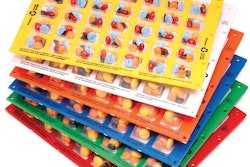The management of all these assets is tough enough for many consumer packaged goods companies. It often worsens when products are marketed globally. The process is tedious because packages and other brand assets are developed from an array of sources, such as design agencies, worldwide. When that happens, the result often is packaging that doesn’t look consistent on shelf from country to country.
New graphic life-cycle management systems are coming onto the market to help brand owners solve this challenge as it relates to the design-to-print process. CPG companies that are using these systems are beginning to achieve success. However, for proprietary reasons, they hesitate to discuss the details. But, Shelf Impact!, working with Sun Branding Solutions (www.sbrandtech.com), one provider of such systems, culled together a generalized case study based in part on a CPG company’s approach using its Online Digital Information Network (ODIN) to store, access, route, and distribute brand assets, such as package-design files.
Healthcare company project
The CPG company is a global healthcare brand owner whose objective was to streamline the design-to-print process from a single global platform. The company operates in 60 countries, with more than 40 manufacturing facilities, and markets its brands in 180 countries.
Lacking a graphics life-cycle management system, the healthcare brand owner sought a comprehensive way to streamline the design-to-print process and thereby expedite and more cost-effectively operate across all its worldwide markets. Because the company worked with numerous agencies, little transparency or control existed over brand assets. Contributing to the inefficiencies, those assets, including design and artwork, were stored on multiple disparate systems.
“Packaging, from a structure and graphics standpoint, is all about efficient management of data,” says Jim Burk, sales director North America, Sun Branding Solutions.
Through ODIN, the healthcare brand owner has eliminated or greatly reduced a host of online data-management inefficiencies, and anticipates it will save more than $11.45 million over three years. The savings are expected in large part because the brand owner has been able to automate localized artwork derived from brand master artwork templates. Equally important is the ability to easily move artwork efficiently and rapidly through the chain of approval while also monitoring, analyzing, and improving process workflows.
The system was put in place by starting a pilot model that included nine countries, eight of the healthcare company’s brands in 23 categories, and 10 departments. The successes derived from the pilot model were then put in place globally.
Those who were involved in the pilot noted numerous advantages of ODIN. These included intuitive project management, digital asset management, automated artwork, and artwork-approval tools. ODIN operates via a Web browser, making a project’s current status accessible from anywhere in the world. This approach automates and streamlines the entire brand-implementation process, freeing the brand owner to concentrate on other value-added activities. Meanwhile, online project management is streamlined so all team members can more easily fulfill their roles in the project.
Five benefits result
CPG companies that have adopted ODIN to help facilitate their creative processes have noted five benefits of the resulting streamlined processes for new product development and design-to-print graphics:
• An overall sense of being able to “work smarter.”
• The elimination of duplication and time and money wasted in sending hard copy and PDF proofs in an uncontrolled and unscheduled manner.
• An end to individual interpretation of brand guidelines, with little reference given to previous work. As a result, the greater diversity in finished packaging, among other brand assets, has been eliminated, thereby making the branding look more consistent globally.
• There was also a sense that the constant battling had lessened or ceased among brand managers for getting the time and resources, when needed, to complete projects—a bottleneck that previously resulted in their brands falling behind competitors.
• The elimination of on-pack mistakes attributable to human error and increased costs related to package recalls.
Since implementing ODIN, the healthcare brand owner also has noted time and cost savings in creating artwork, improvements in process management, and more organized activity planning. The result is an increase in on-time product launches. {SI!}


























